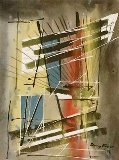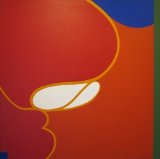



Untitled (Flowers in a Vase) 1995 23x18
Richard Klix
Original Painting : Oil on Canvas
Size : 23x18 in | 58x46 cm
Reduced
-
🔥Oil on Canvas - A Steal - 3 Watchers $$$$$$$
Year1995
Not Signed
Condition Excellent
Not Framed
Purchased fromDealer 2014
Certificate of AuthenticityArt Brokerage
LID97722
Richard Klix
Art Brokerage: Richard Klix American Artist: b. 1928. After studying with Joseph Albers at Yale, Robert Motherwell at Hunter College, and being influenced in New York City by Abstract Expressionists, Richard Klix developed his own form of expression in the middle 1950's. Using an impasto line squeezed from a rubber bulb syringe, he produced color fields of "ideographs." These ideographs done in "Op" colors and flat patterns were done rapidly and spontaneously in an attempt to outrun thought and allow the free play of the unconscious. He "wrote" these syringed figures or pictographs by the hundreds and did not repeat any of them in the same painting. After years of following the Abstract Expressionist's dictom to "paint out anything that looked like something," his need for a more inclusive art brought realistic subject matter onto the canvas in the form of dream images. By the end of the 1970's, Richard Klix used transparent aura figures to help him express the ineffable aspects of out nature. In the 1980's paintings that tried to reconcile abstraction with realism, ideographs with surreal images; transparent aura figures with more abstract line patterns and the spontaneous with the designed were produced. The transparent figures are not intended to look metaphysical, but are an attempt to keep the figure from jumping off the picture plane. They do serve, however, to remind us that we are our environment and not apart from it. The paintings are meant to transcend the polarization and divisiveness of thought by wedding figure and ground through the illusion of transparency and line. With partly filled in or fleshed in figures, an expressive contrast amplifies the transparent figures. The artist has never felt the commercial need to do a consistent style of work, yet through the body of experiments and endeavors there runs a spiritual theme. The artist recognizes the divinity of all things, thus the variety in his paintings. Original paintings wanted.










































































